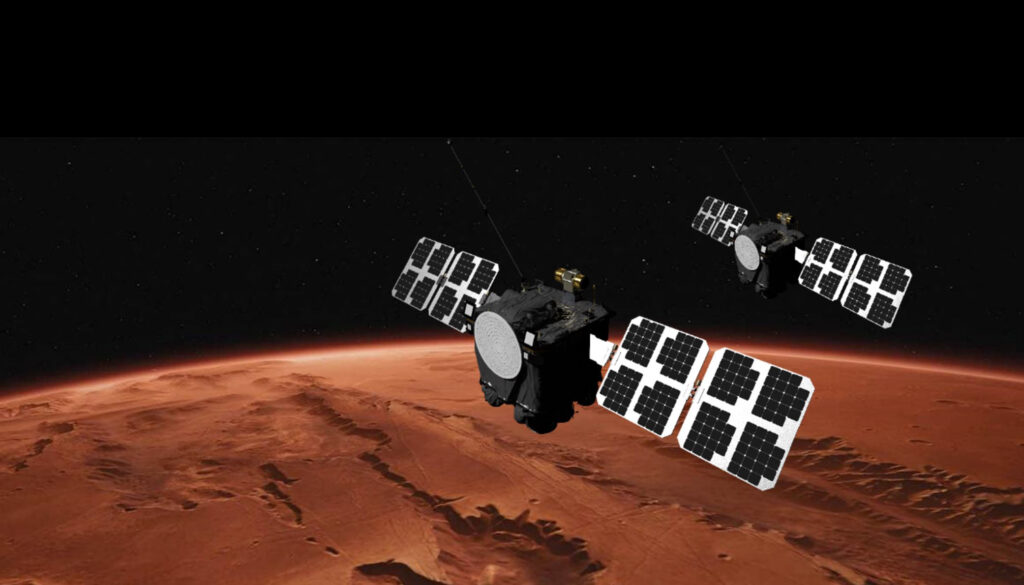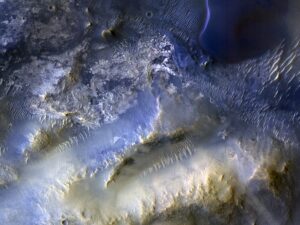
The first dual-satellite mission to another planet, NASA’s ESCAPADE (Escape and Plasma Acceleration and Dynamics Explorers), is set to launch in early November from Cape Canaveral, Florida. This groundbreaking mission, managed by the University of California, Berkeley, will see two identical spacecraft flying in formation to map Mars’ magnetic fields, upper atmosphere, and ionosphere in 3D. This stereo view aims to provide crucial insights into the Red Planet’s unique near-space environment.
The mission’s findings are expected to shed light on how and when Mars lost its atmosphere, offering vital information for future human missions. “Understanding how the ionosphere varies will be a really important part of understanding how to correct the distortions in radio signals that we will need to communicate with each other and to navigate on Mars,” said ESCAPADE principal investigator Robert Lillis of UC Berkeley’s Space Sciences Laboratory (SSL).
Innovative Scientific Objectives
The satellite pair, nicknamed Blue and Gold in honor of UC Berkeley’s school colors, will be operated from SSL’s mission operations center (MOC) in the hills above the Berkeley campus. The science instruments and data processing computers were developed by UC Berkeley and its partners, while Rocket Lab USA built the spacecraft. The mission will be launched aboard a New Glenn rocket from Blue Origin.
Mapping Mars’ magnetic fields is critical because, unlike Earth, Mars lacks a global magnetic field and a thick atmosphere to shield its surface from solar storms. This leaves potential settlers vulnerable to high-energy particle radiation, which can increase cancer risks. Lillis highlighted the significance of these measurements, noting, “We will be making the space weather measurements we need to understand the system well enough to forecast solar storms whose radiation could harm astronauts on the surface of Mars or in orbit.”
Pioneering New Trajectories
ESCAPADE will also explore a novel trajectory to Mars. Traditionally, missions to Mars launch within a narrow window every 26 months, utilizing a Hohmann Transfer, which is the most fuel-efficient route. However, ESCAPADE will first travel to a Lagrange point, where the gravitational pull of the sun and Earth are balanced, before looping back toward Earth and slingshotting to Mars.
This innovative approach could revolutionize how missions are launched to Mars, allowing for more flexibility and reducing dependency on precise planetary alignments. “Can we launch to Mars when the planets are not aligned? ESCAPADE is paving the way for that,” said Jeffrey Parker of Advanced Space LLC, a NASA partner on the mission.
Historical Context and Future Implications
UC Berkeley has a long history of contributing to Mars exploration, with instruments on missions like NASA’s Mars Global Surveyor and MAVEN. These missions have revealed that Mars once had a global magnetic field, which disappeared about 4 billion years ago. ESCAPADE’s dual probes will continue this legacy by providing a 3D view of how the Martian atmosphere responds to solar wind, helping to understand the planet’s climate evolution.
The mission’s data could also offer clues about the fate of water on Mars. “The geological evidence shows that Mars once had water on it, and in order to keep the water, you need a thick atmosphere,” explained space physicist Shaoxui Xu, deputy principal investigator for the mission. Understanding atmospheric escape is key to piecing together Mars’ climatic past.
A New Paradigm in Space Exploration
Since its inception in 2016, ESCAPADE has embodied a new approach to space exploration, with lower costs and increased commercial involvement. The mission was selected for NASA’s SIMPLEx program, designed to support cost-effective planetary exploration. “ESCAPADE represents a new way of doing things, with much lower cost, more commercial involvement, and a somewhat higher risk tolerance,” Lillis said.
Once the satellites reach Mars, they will settle into synchronized orbits, allowing for unprecedented monitoring of the Martian environment. This capability will enable scientists to observe short-term variability in the system, offering insights that previous missions could not provide.
While the mission holds great promise for advancing our understanding of Mars, Lillis admits that human settlement on the planet will be challenging. “With extremely low atmospheric pressure, your blood would boil without a pressure suit,” he noted, emphasizing the need for underground living to avoid cosmic radiation. Yet, the mission’s success could be a stepping stone toward overcoming these challenges and realizing the dream of human settlement on Mars.







